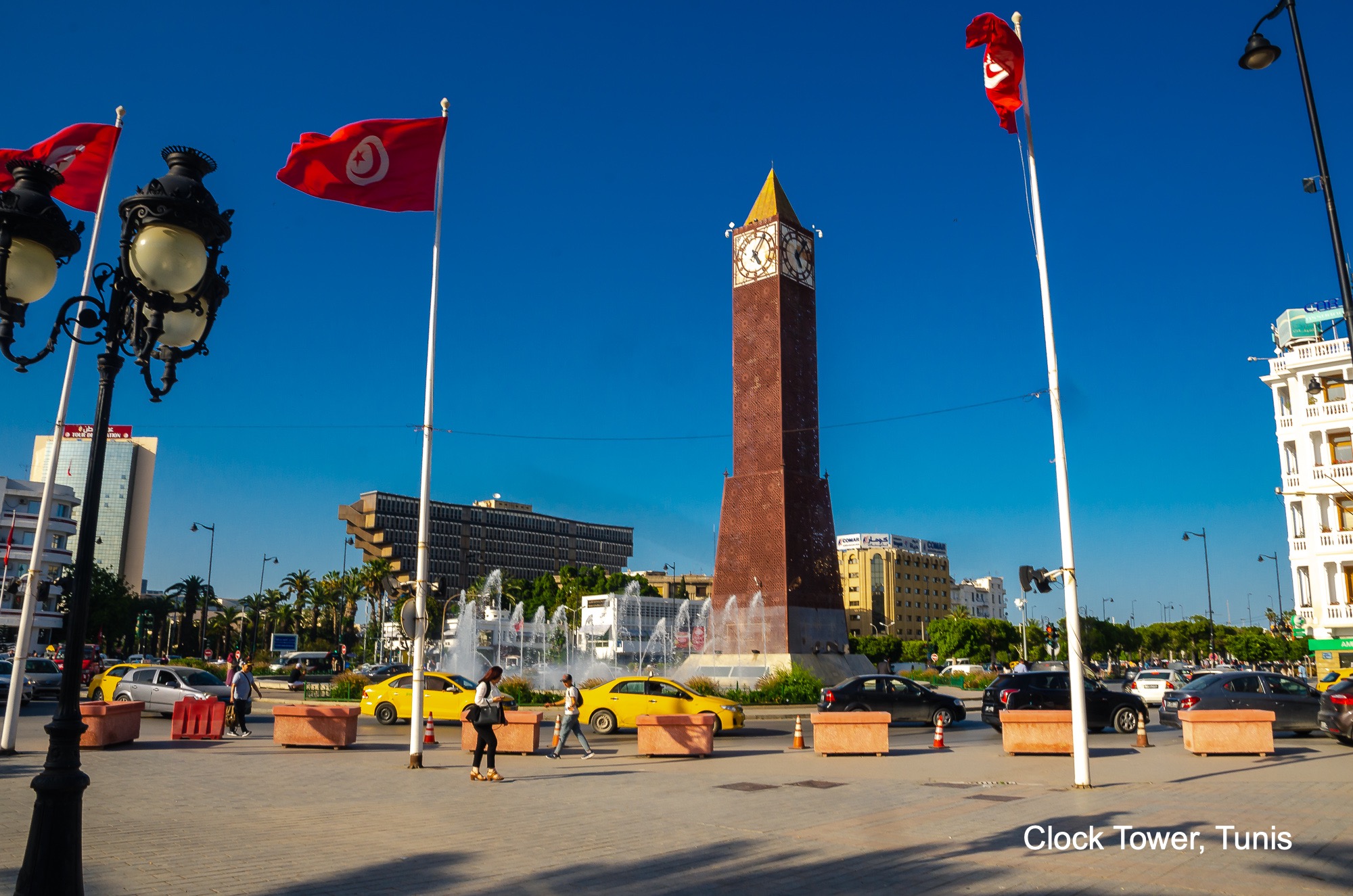In this compact country there are beautiful beaches, historic medinas, Roman ruins, mountain hiking and camel rides, as well as a wide range of restaurants, cafes and bars. There are even many Star War filming locations here. In fact, the desert planet Tatooine name comes from the Tunisian city of Tataouine.
The country balances traditional Islamic culture with modern sensibilities and is well known for its hospitality. Since its independence from France in 1956, Tunisia has been a haven for tourists, especially French and Italian. However, three events have reduced it materially. In 2010, political instability during the Arab Spring ousted longtime dictator Ben Ali. In 2015, the Islamic State attacked tourists in two separate incidents. Then in 2020, Covid started and depressed tourism worldwide. As a result, when we visited this remarkable country it was uncrowded and inexpensive.
Where is Tunisia?
Tunisia is situated between Algeria and Libya, bordering the Mediterranean Sea with a maritime border with Italy.

Why We Went to Tunisia
My wife Khadija and I always wanted to visit our friends Marcello, Ada and their son Alessandro in Tunisia, as they had been working there for several years. Khadija and Ada were colleagues at the United Nations. As we were going to Malta in May 2022, we arranged to subsequently go to nearby Tunisia to visit them and see the country for the first time.
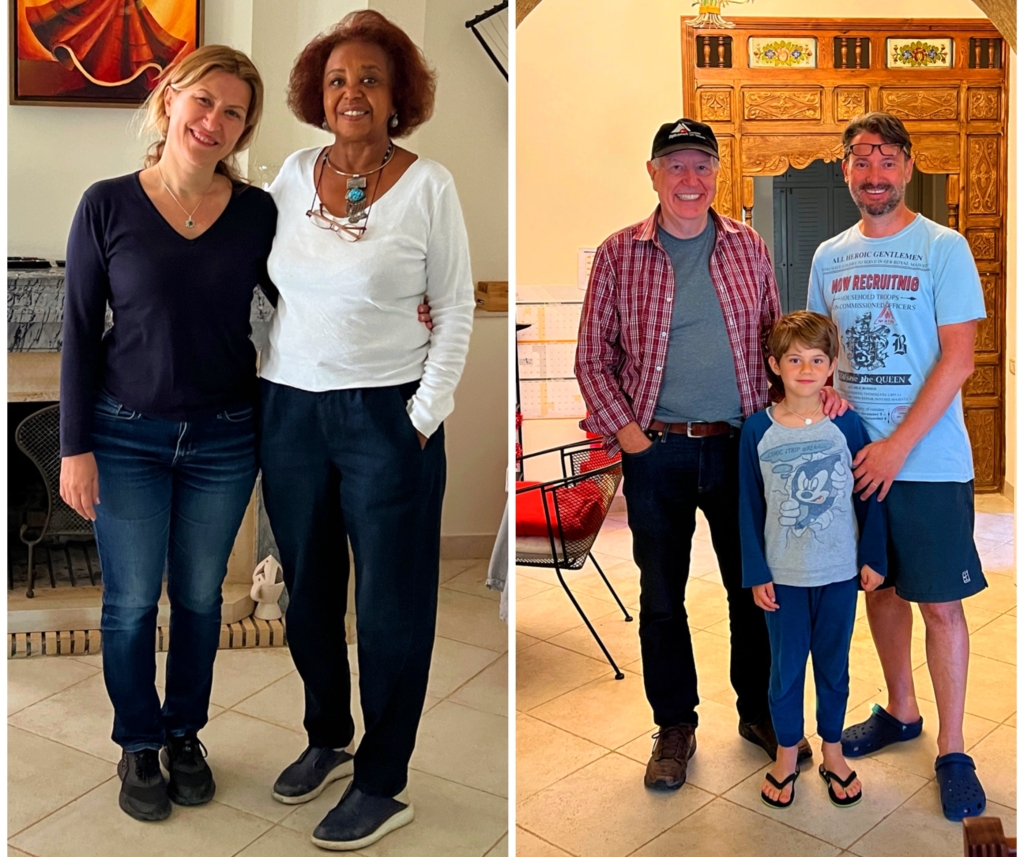
Good thing we went when we did, as they were in the process of moving back to Europe. In fact, Ada left two days before we did and Marcello and Alessandro were staying just a few more weeks.
As mentioned, this is a new country for me. However, I decided to make my goal the number of UN member states which is 193, not 197 which included Kosovo, Palestine, the Vatican and Taiwan. Using the UN member states, this is my 112th country.
How Long to Spend in Tunisia
We spent seven days in Tunisia, but for the amount of traveling we did, we should have allocated ten. In two weeks, you can see most of the highlights. If you can spend even more time, you can relax on the Mediterranean, have adventures in the desert and importantly not feel rushed to go to the next attraction.
Is Tunisia Safe?
It’s safe and we drove in a rental car throughout the country with no problems. Here, as everywhere you travel, employ basic safety precautions and use common sense to avoid problems.
Is Tunisia Expensive?
We went in May 2022, where Covid was limiting travel worldwide, and Tunisia had few visitors. As a result, prices were lower than normal and some merchants were anxious to sell their carpets, blankets, pottery, etc. Dinners at good restaurants were not expensive. Tourist hotels were relatively more expensive than others.
Where to Stay in Tunisia
While in Tunis we stayed with our friends Marcello and Ada. We found there’s lodging in most places for every budget. In each section of the post, I’ll mention where we stayed.
How to Get Around Tunisia
We chose to drive an inexpensive rental midsize sedan. We could only do this trip by car as it was impractical to travel by public transportation in a reasonable time. While driving provides flexibility, sometimes we had difficulties finding remote destinations. Twice we were stuck in sand and needed help to dislodge. In retrospect, we would’ve spent the extra money and rented a small SUVwith high clearance.
We drove several hours on many days because the distances took longer than expected and we didn’t always take the most direct route. In some places, our SIM card didn’t have service and we couldn’t access Google maps, so we had to ask for directions. We should’ve downloaded a map from maps.me, so we could’ve known where we were (you can access GPS even if you do not have cell service).
The many speed bumps on the roads and highways were a challenge. Often they were hard to see, not well marked and in places you wouldn’t expect. As an alternative, there are many tours available which are efficient in seeing a broad stretch of the country.
Here’s a map of the places we went.
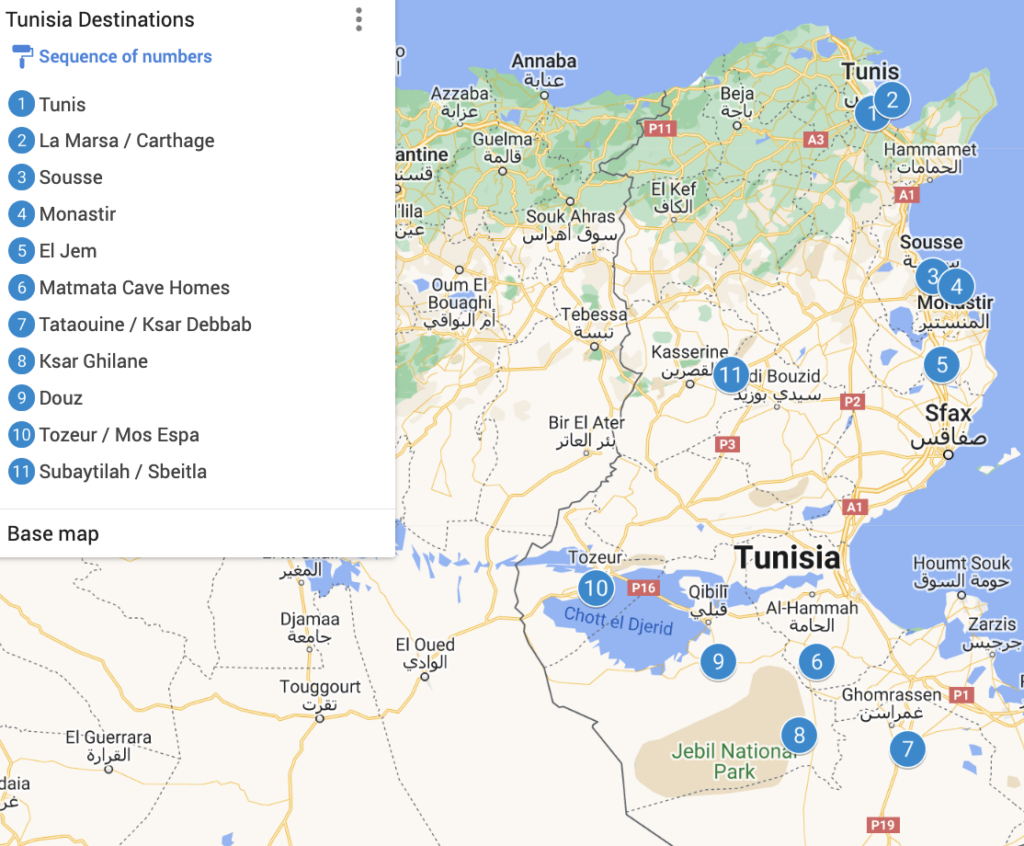
What Languages to Use in Tunisia
The area that is now Tunisia came under Islamic governments during the Umayyad Caliphate in 670 AD. Since then, the population has remained almost completely Muslim and virtually everyone speaks Arabic. Arabic is the sole official language according to the Tunisian Constitution. Many people speak French but it has no official status. English is spoken by some, especially in the hospitality industry.
Tunis
Tunis is the largest city and the capital of Tunisia. It’s located on the Lake of Tunis which is connected to the Gulf of Tunis and the Mediterranean Sea by a large canal. The sprawling metropolitan area is home to about 2.7 million people and is often referred to as “Grand Tunis”.
Tunis started as a Berber settlement and has always been a large trading hub because of its proximity to the Mediterranean. From the 12th to the 16th century, Tunis was one the wealthiest cities in the Islamic world.
The Medina of Tunis is the historic center of the city with many buildings existing since the 7th century. In 1979, it was one of the first cities to be designated a UNESCO World Heritage Site. The Medina area contains hundreds of palaces, mosques, mausoleums, madrasas and fountains but the main joy for me was walking among the throng of people in the covered shopping area.
There’s a maze of pedestrian alleys and it’s not a bad idea to hire someone to guide you through but it’s not absolutely necessary. More likely someone will approach you, tell you about something you should see (e.g., an art exhibition), then start taking you to carpet, perfume and other shops where they no doubt get a commission if you buy something. Then at the end, you will have to haggle over a tip.
The streets had a charm with their deteriorating facades and the repairs to them.

Another highlight of Tunis is this imposing clock tower, 38 m / 125 ft high, nicknamed “Big Ben Ali” because it was erected in 2001 by the dictator Zine El Abidine Ben Ali.

Unfortunately, the Bardo National Museum was closed. It has a spectacular collection of Mediterranean objects, especially Roman mosaics.
La Marsa / Carthage
The northern suburb La Marsa attracts expats because of its many cafes and restaurants, such as Au bon vieux temps where you can choose from perfectly cooked spaghetti, terrine and paté. It’s an option to stay in Tunis if you have a car. La Marsa is only 5 km / 3 mi from the Carthage Archeological Site in the tony suburb of Byrsa, pictured below.
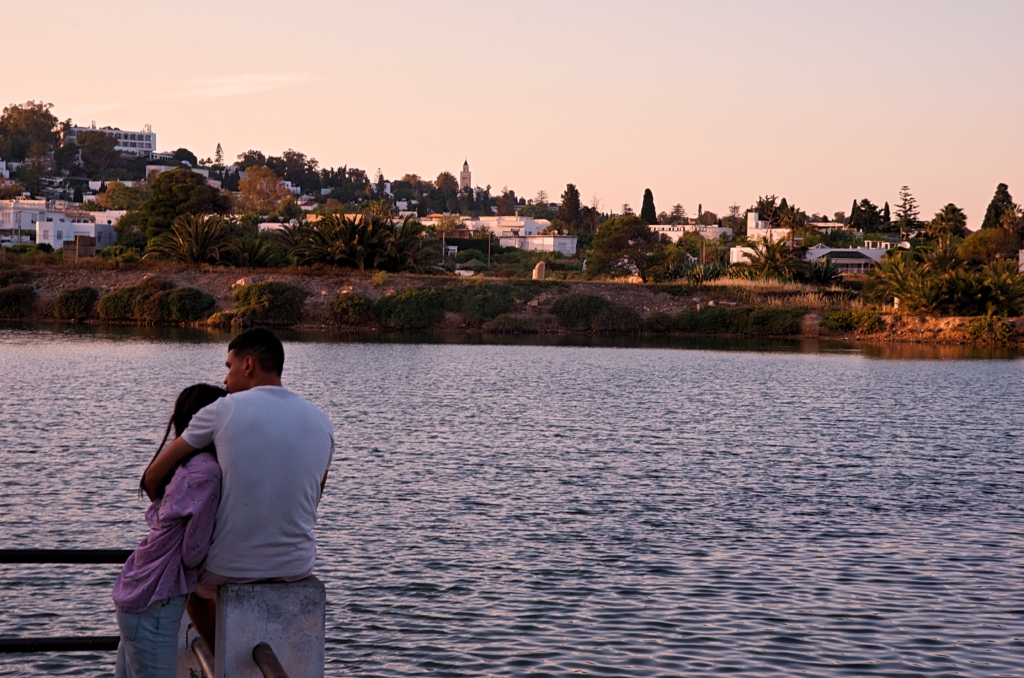
The city of Carthage started as a Phoenician colony and developed into a Punic empire. The Punic people were the western branch of Phoenicians, a Semitic people from current-day Lebanon. It became one the wealthiest states in the first millennium BC and an important commercial center in the Mediterranean. Eventually it expanded into a nation that hugged the coast of the Maghreb and occupied part of the Iberian peninsula.
Carthage engaged in three long wars with Rome (Hannibal crossed the Alps with elephants in the second one) known as the Punic Wars. Unfortunately for Carthage, they lost all of them. After the third Punic war in 146 BC, the Romans captured and burnt the city, killed the men and enslaved the women and children. Various texts claimed that the Roman plowed over the destroyed city and spread salt in the soil so nothing could grow. A century later, the Romans rebuilt Carthage as a Roman city.
Within the sprawling archaeological site, the ruins reflect the eras of the Carthaginian, Romans, Vandals, early Christians and Arabs. We arrived after 7pm and it was closed. I’m not too disappointed, as the history is the important part to me and few structures are from pre-Roman Carthage. In fact, Kerkouane (Kerkuane) on the Cap Bon peninsula (two hour drive from Tunis) is the only surviving example of a Punic settlement.
Perhaps on our first day in Tunis, we should’ve taken a half-day tour of the Carthage archeological site and the medina in order to efficiently see them and not miss major attractions. Afterwards, we could’ve walked the streets of the medina to sample street life.
Sousse
Sousse is known for its medina, a UNESCO World Heritage Site, and enormous beaches. We skipped it and decided to spend our time in Monastir, which has similar coastal architecture and military fortifications. We’d also just spent a day in the Tunis medina, so we decided seeing two (Tunis and Monastir) was sufficient. If our trip was, say, two weeks instead of one, we would’ve spent at least a day there.
Monastir
Monastir (Mestir) is a peninsula off the central coast of Tunisia, south of Sousse.
The Ribat of Monastir is an Islamic defensive structure used to scan the sea for invading ships.
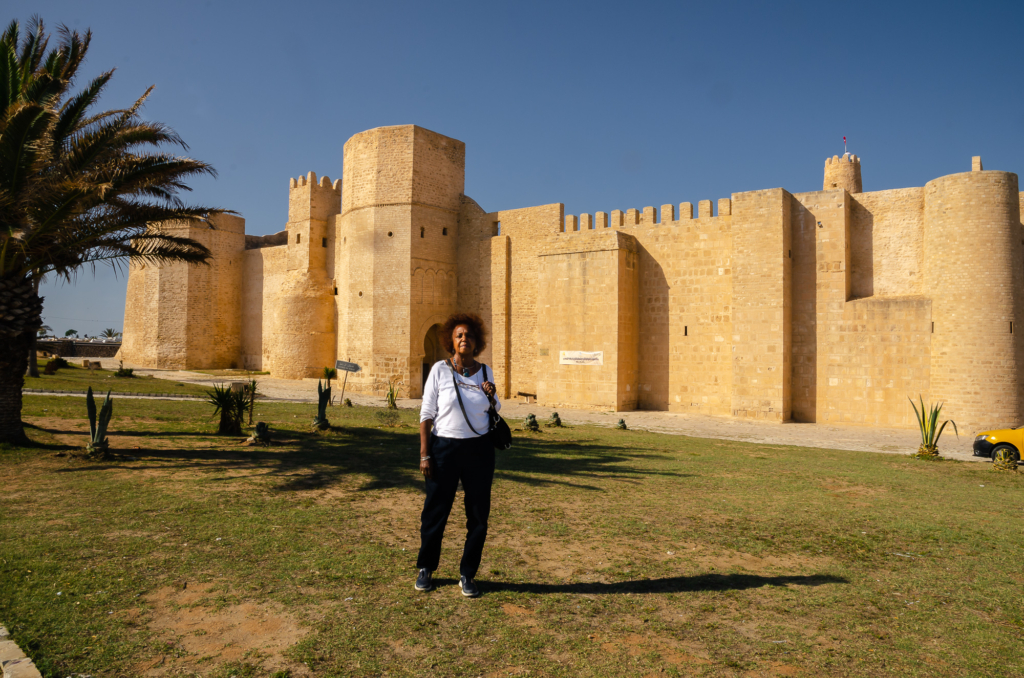
It’s the oldest ribat built by the Arabs during their conquest of the Maghreb. Construction on the ribat started in 796 AD and expanded over the centuries.
Habib Bourguiba, who led the country as prime minister of the Kingdom of Tunisia (1956-57) and then as the first president of Tunisia (1957–87), was born in Monastir. His mausoleum still resides there where he is buried with his wife; a large domed edifice surrounded by a cemetery of above-ground, concrete tombs.
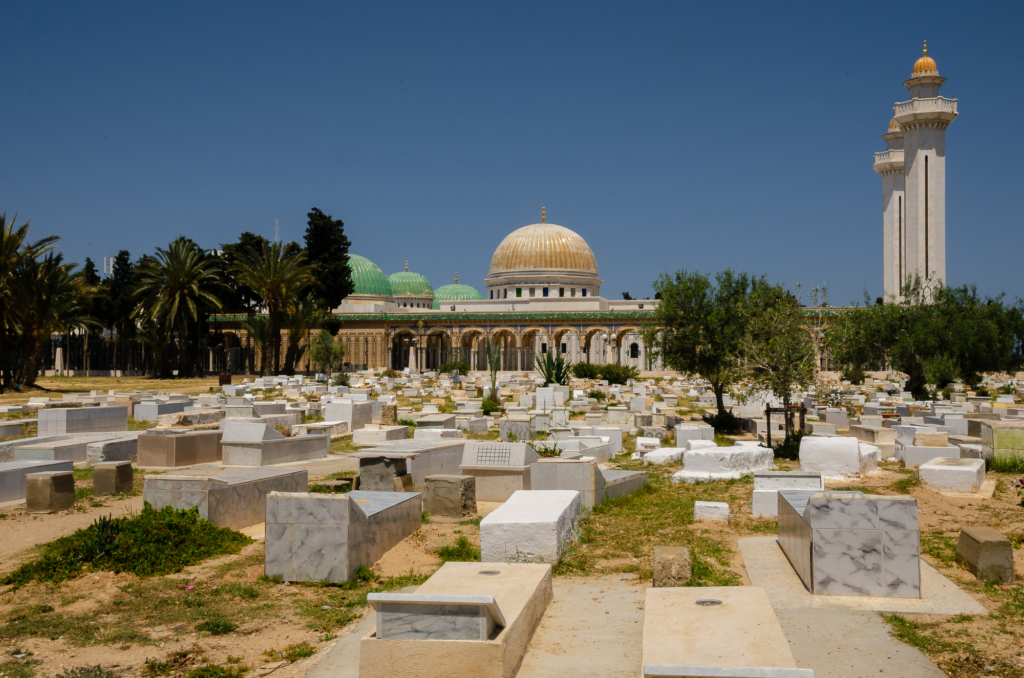
You can visit inside the mausoleum. Besides the tombs, there are displays of family memorabilia and several pictures of him with world leaders, including one where he is pointing a finger to and lecturing Saddam Hussein.
The towering influence of Bourguiba can also be seen in the Bourguiba Presidential Palace, an oversized summer residence furnished with trendy 1970s decor. My favorite item was his Mercedes presidential car.
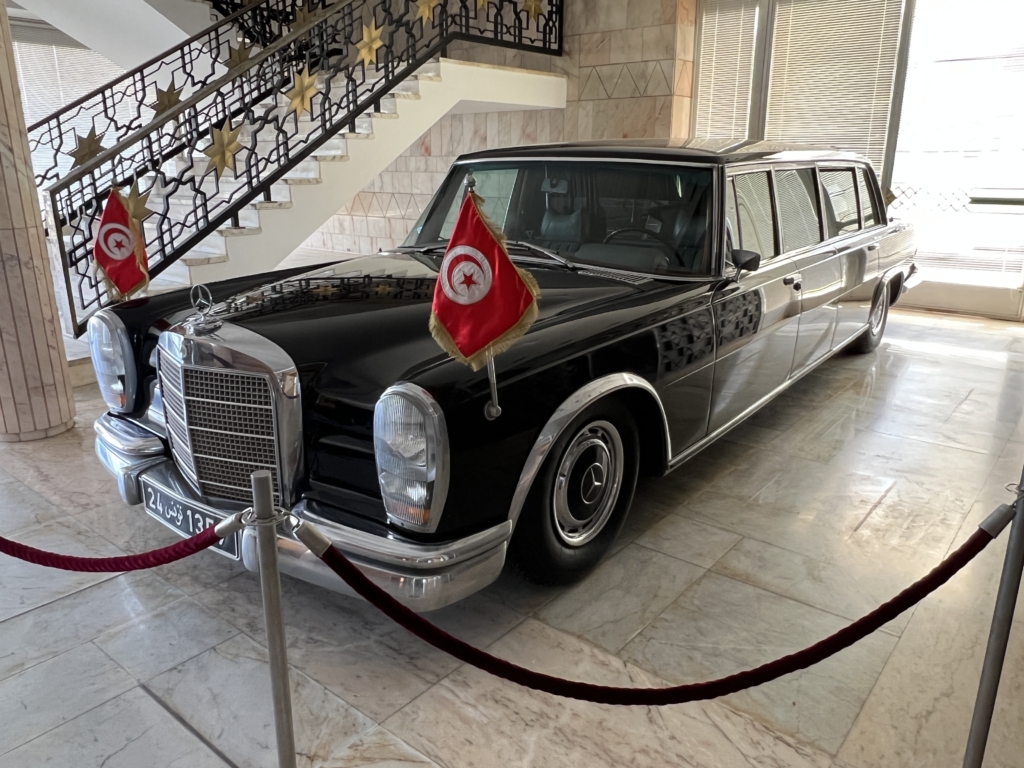
We stayed in the renovated and eclectically furnished Dar Benti Hotel, which was conveniently inside the walled medina.
We ate well in Monastir and in some places multiple bartenders were filling orders nonstop. We also had coffee and delicious desserts in some cafes. However, here and throughout Tunisia, most cafes were occupied only by men and did not seem welcoming to women.
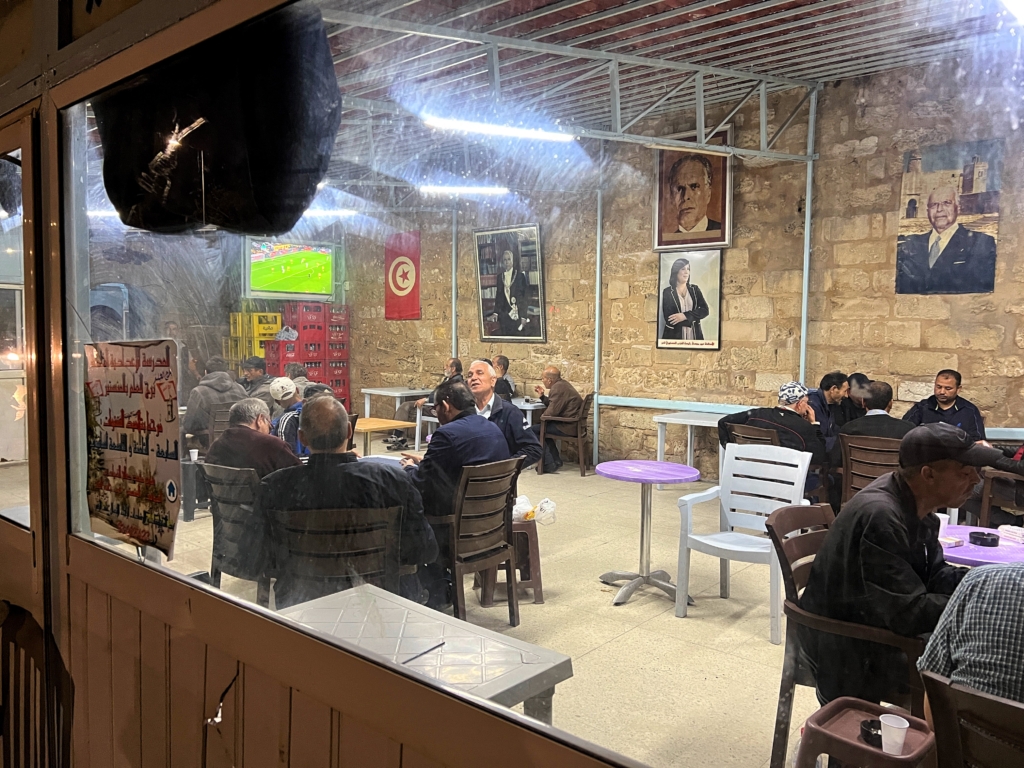
El Jem
The Amphitheatre of El Jem is in the city of the same name, formally the Roman city of Thysdrus. It seated about 35,000 spectators with only the Colosseum in Rome (seating about 50,000) and the theater of Capua (seating about 60,000) outnumbering it.
Like other Roman amphitheaters/coliseums, it was famously used for gladiator exhibitions and small chariot races. The amphitheater remained whole until the 17th century when stones from the structure were taken to build the town of El Jem and transported to Kairouan for the construction of the Great Mosque. The Amphitheatre of El Jem is a UNESCO World Heritage Site.
We arrived after it was closed, but persuaded a guard to let us in. A highlight of our trip was experiencing the dramatic light of sunset.
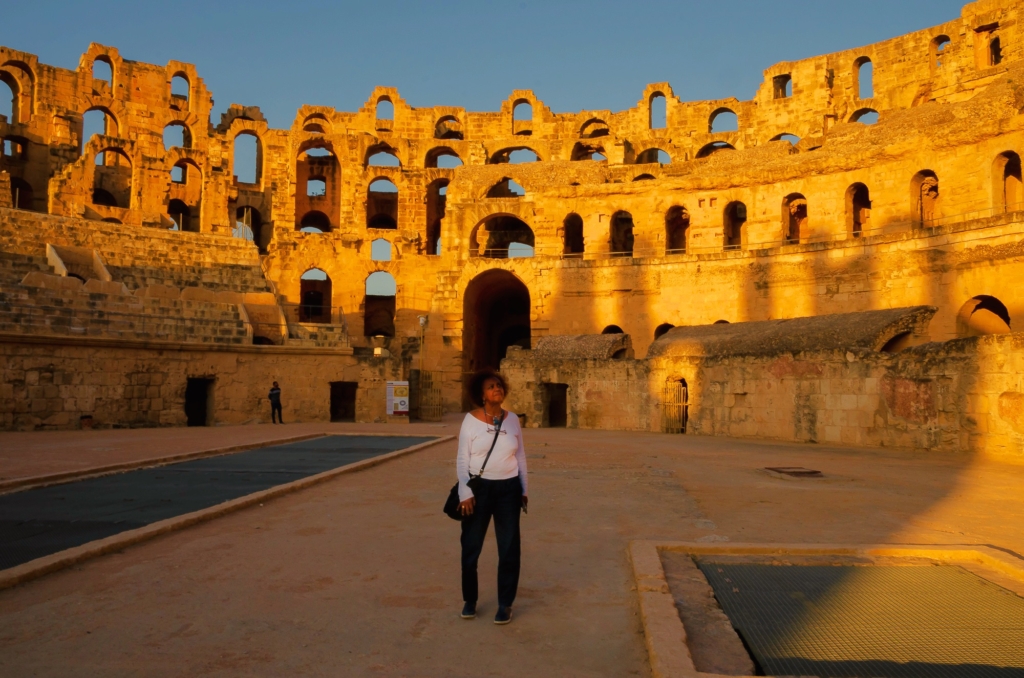
Matmata
Matmata is famous for its “troglodyte” or cave housing. Each home buried into a hill has rooms connected through passageways. About 1,200 of the homes have been preserved and some are still used by locals.
The Hotel Sidi Driss in Matmata was used in 1976 as a filming location in Star Wars Episode IV: A New Hope, for the home of Luke Skywalker, his Aunt Beru Lars and Uncle Owen Lars on the planet Tatooine.
We stayed in the Au Trait d’Union Tijma Matmata Hotel cave hotel for a night, so we felt the vibes of living in such a place.

Tataouine
We went to Tataouine because George Lucas used this name for his desert planet in Star Wars, where Luke was raised on the Lars farm and outlaws drank and fought in the Mos Eisley bar. In Star Wars, the name is spelled Tatooine.
I was expecting Star Wars souvenirs and paraphernalia everywhere. Quite the opposite, we saw no trace of the franchise and it’s not a tourist destination. We walked some of the streets with vegetable and fruit stands, but many were closed during the mid-afternoon break. On the hill outside of the city, “Welcome to Tataouine” was written in Arabic.

Ksar Ouled Debbab
A ksar is a combination of a granary and a fort and there are over 70 in Tunisia. Any trip to the country should include visiting some.
We drove to Ksar Ouled Debbab, outside of Tataouine, and found no other visitors. Oddly, it had dinosaur figures and I have no idea why.
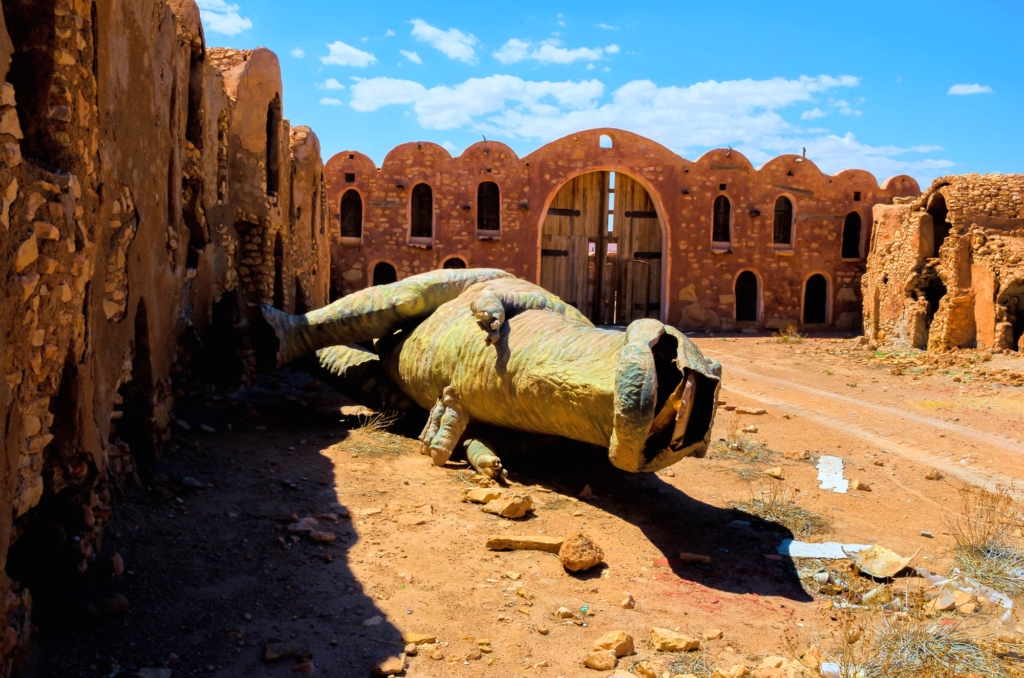
It also had a hotel where we bought cappuccinos from someone who appeared from nowhere and drank in a cool (temperature) room, but it seemed the hotel had no occupants.
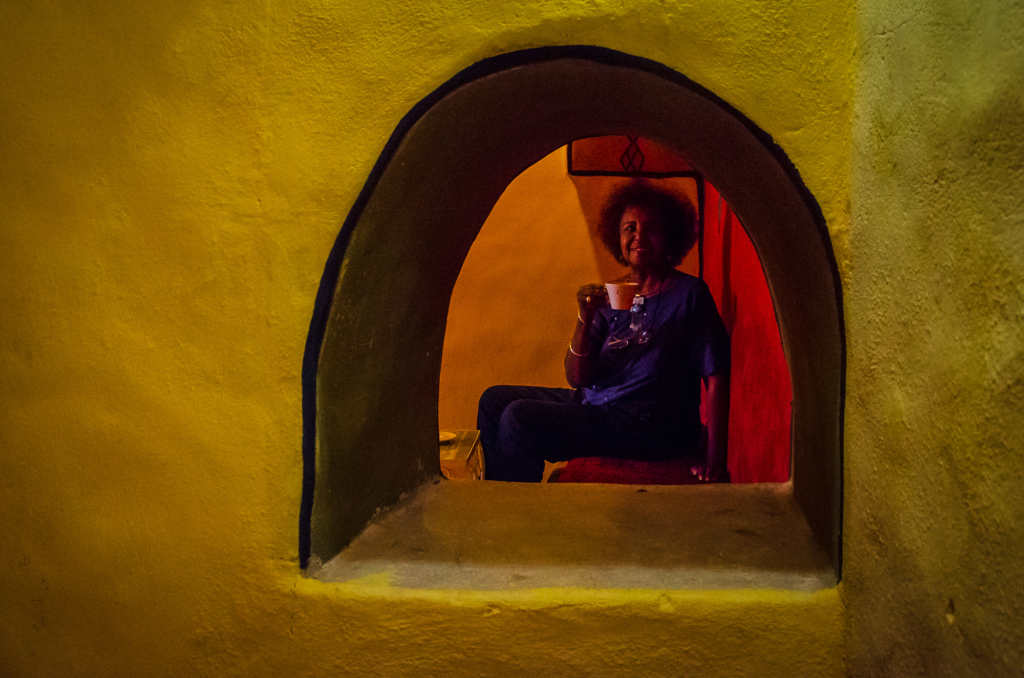
Ksar Ghilane
Ksar Ghilane, the southernmost oasis in Tunisia, is considered one of the gateways to the Tunisian Sahara desert. It used to be a stopping place for nomadic Berber tribes, but more recently around fifty tribes have settled there and now call it home. The oasis was created by nearby hot springs that feed water into the settlement and create thermal pools that are relaxing to soak in.
We were lucky enough to spend the night glamping under luxurious, air-conditioned tents at Hotel Pansy, one of the three campsites open to visitors.

The hotel is popular with Tunisian families, as the kids can camp and the parents do not have to rough it. It also arranges outdoor activities such as excursions into the desert on camels, ATVs and 4×4 vehicles.
For a long time, Ksar Ghilane was difficult to reach but now it has a paved access road.
Douz
Also located in southern Tunisia, Douz is known as the “ultimate palm oasis” because it’s home to over 500,000 date palm trees that produce Deglet Noor dates (straw yellow to amber toned and oval in shape). Douz is also famous for its International Festival of the Sahara (also called the Camel Festival) which is a four-day celebration featuring music, dancing, poetry readings, horse racing, and camel wrestling (yes, there’s such a thing).
We visited the small but informative Museum of the Sahara, which exhibits traditional nomadic culture including a display of facial tattoos of women.
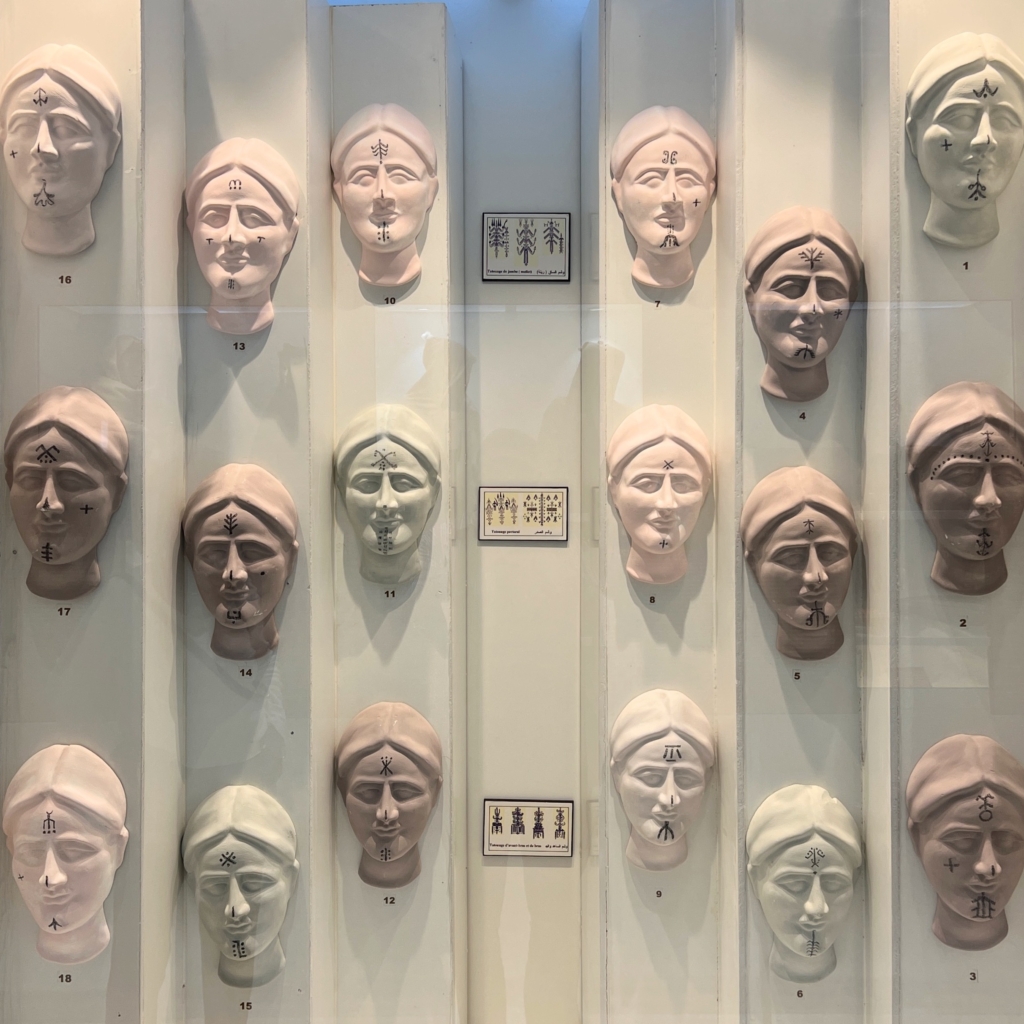
Chott el Djerid
Chott el Djerid on the map is a huge lake. It’s more of a salt plain which has little water most of the year.
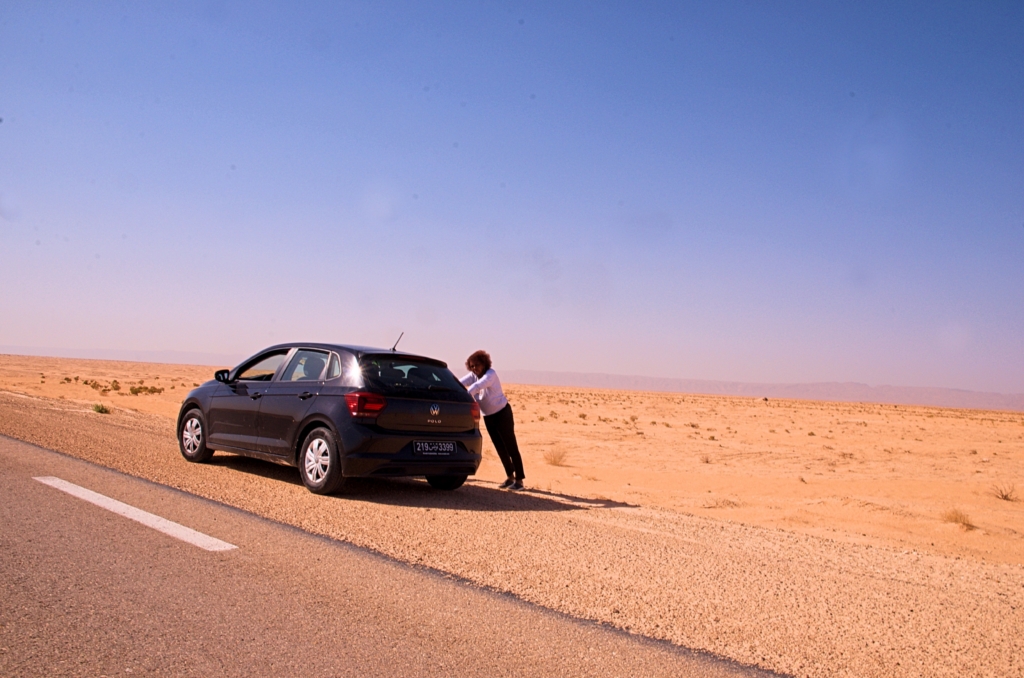
Most of it looks like a desert, in a few areas salt is visible. The name can be translated from Arabic into English as “Lagoon of the Land of Palms.”
Tozeur
Tozeur is an excellent place to use as a base for exploring oases, hot springs, small villages and a Star Wars filming location, as well as for arid hiking, riding an antique train and sightseeing dramatic landscapes. The City of Tozeur is well known for its architecture and palm trees.
Tozeur is famous for its yellow/brownish brickwork, often with geometric designs, which is the style of most buildings in the Ouled el Hadef (Old City or Medina). This area is almost unchanged over the centuries and some of the houses are from the 14th century.
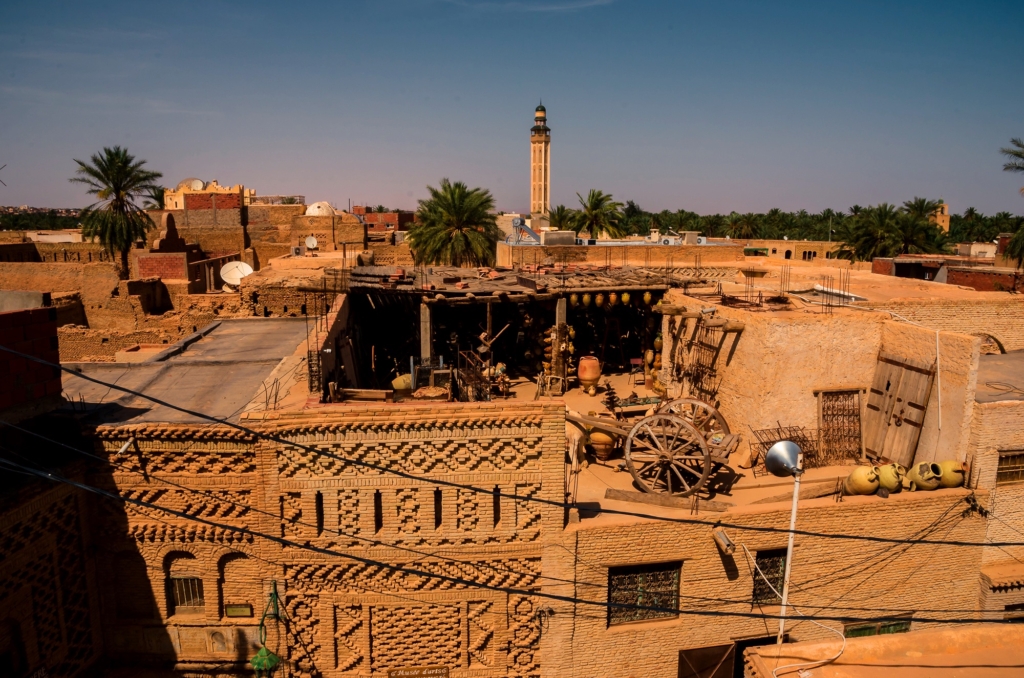
Tozeur is one of the best places in Tunisia for door spotting. Each door often has two or three door knockers. There are multiple explanations of what the number and placement mean. One is the third knocker is added to the door when the family has its first child or son. Another explanation is the right knocker is for the men of the house, the left for the women and the lower for the children. Each knocker gives a different sound, the male knocker the deepest.
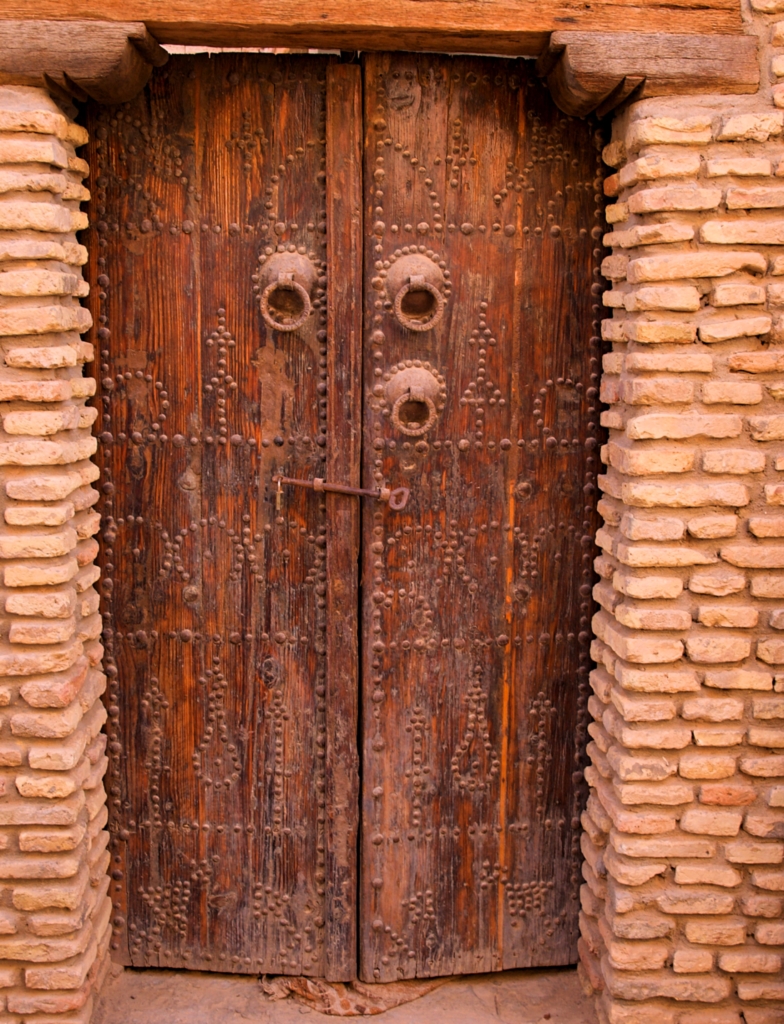
Once we were lost and couldn’t find a place we reserved on booking.com. Luckily, Akram came to our rescue. He runs a clothing and souvenir shop on Bourguiba Avenue and also has a furniture making business.
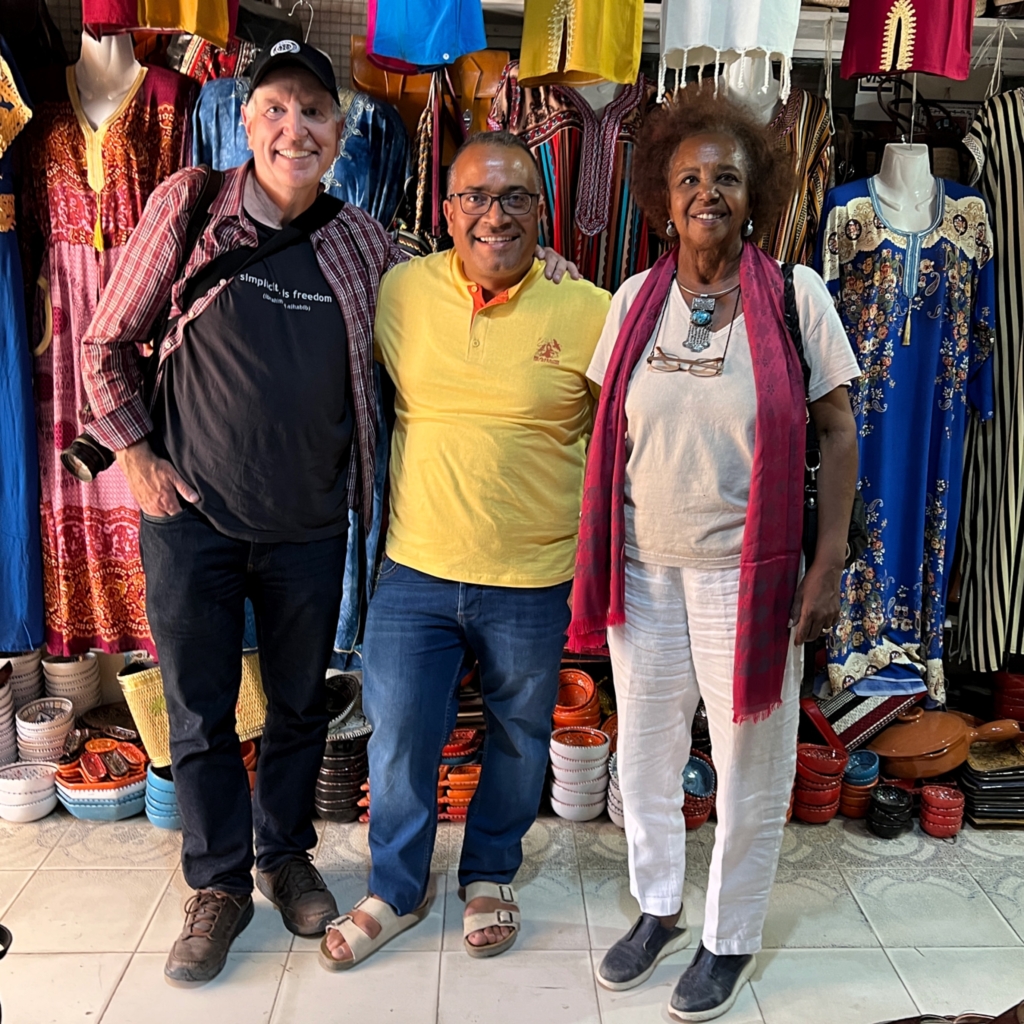
Part of Tozeur is an oasis and has around 400,000 date-palms, which provide shade for fruit trees, including apricots, figs and bananas. The plants are irrigated from 200 springs and a sophisticated irrigation system. Eden Palm is a center with an exhibition on palm trees (surprisingly interesting) and a grove of different species. Here we saw a man with no shoes climb a palm tree as easily as a normal person walks up stairs.
It also has a comfortable café for drinks, coffee and desserts, plus a shop with a wide variety of dates.
The best restaurant we went to in Tunisia was Dar Deba. We ate authentic, sumptuous local cuisine in a relaxing atmosphere and very good service.

We stayed in the inexpensive and clean Hotel El Arich which had a parking lot we used.
Mos Espa
Mos Espa is Tunisia’s best-preserved Star Wars set and a short drive from Tozeur. It’s amazingly intact with around twenty domed buildings in the traditional Berber style that shielded the glare and scorching heat of the two suns.
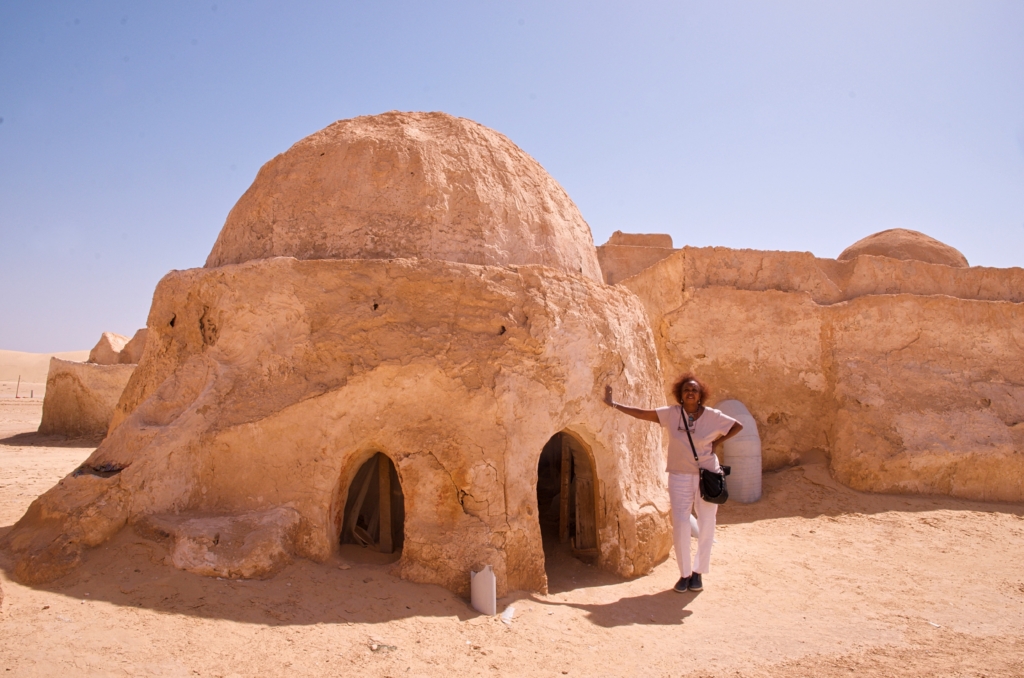
You might even recognize the spaceport on the planet Tatooine in Star Wars: Episode I – The Phantom Menace from 1999.
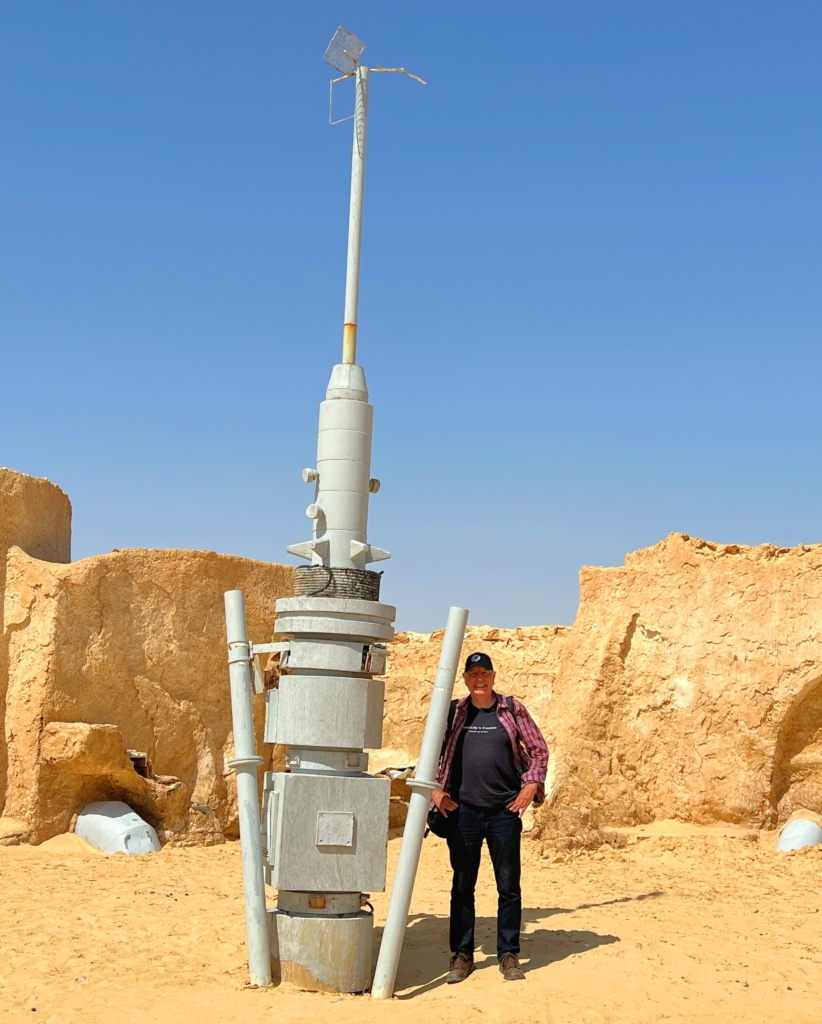
Sbeitla and the Sufetula Roman Ruins
Sbeitla is a small town in west-central Tunisia, known for the Sufetula Roman archaeological park possessing the best-preserved temples in Tunisia. Sufetula originally was a nomadic Berber settlement but was taken over by the Romans and annexed as a province in 67 AD. The province was successful through its olive trade but started to crumble when it was invaded by Vandals at the end of the Western Roman Empire. As a result, there are dedications and tributes inside temples to different Vandal gods. Sufetula was later taken over by the Byzantines before it eventually was conquered by Arabs.
We marveled at the fortified dwellings, oil presses, baths, theaters and temples. The highlight was the Capitolium.

Another amazing feature was the intact mosaics including this one for a bath.
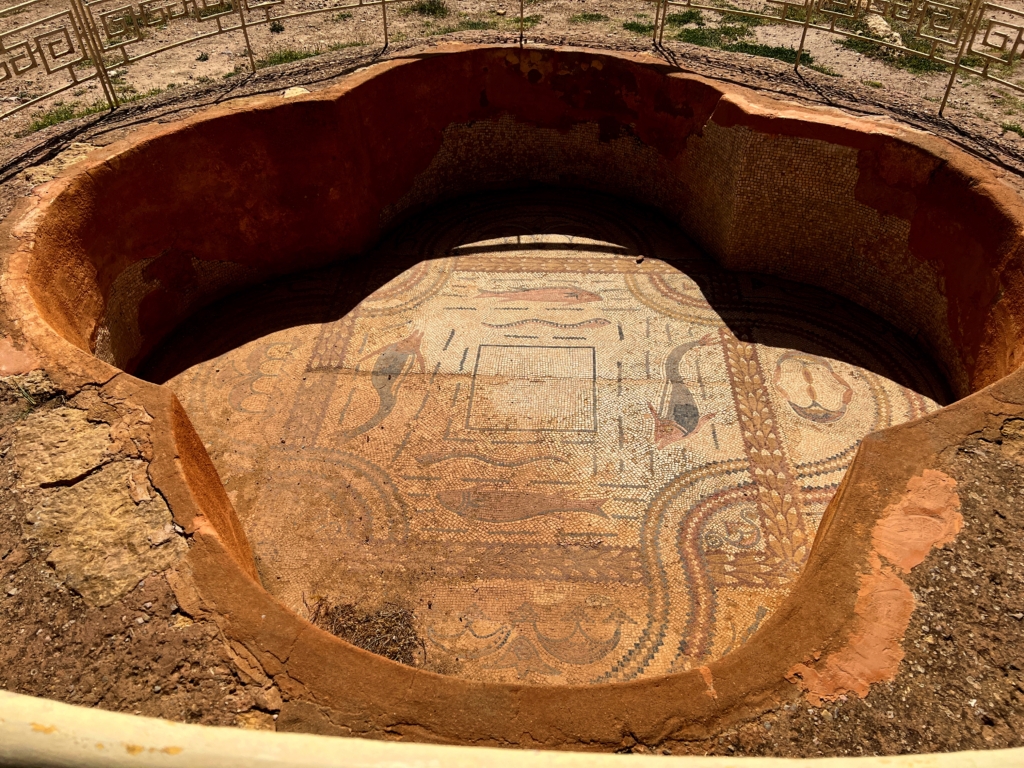
Unlike in Italian Roman ruins, no one else was there except workers.

We stayed overnight in the Hotel Sufetula, which was less than $50/night, comfortable and walking distance to the archeological park entrance.
The Sbeitla Archaeological Museum is across the street and contains sculptures and mosaics.
Final Thoughts
When we toured Tunisia, we constantly encountered magnificent historical sites from over the millennia. There were also the aspects of the day to day life which were interesting. When driving in the Tunisian desert, we saw camels all the time as they grazed on the little vegetation around.
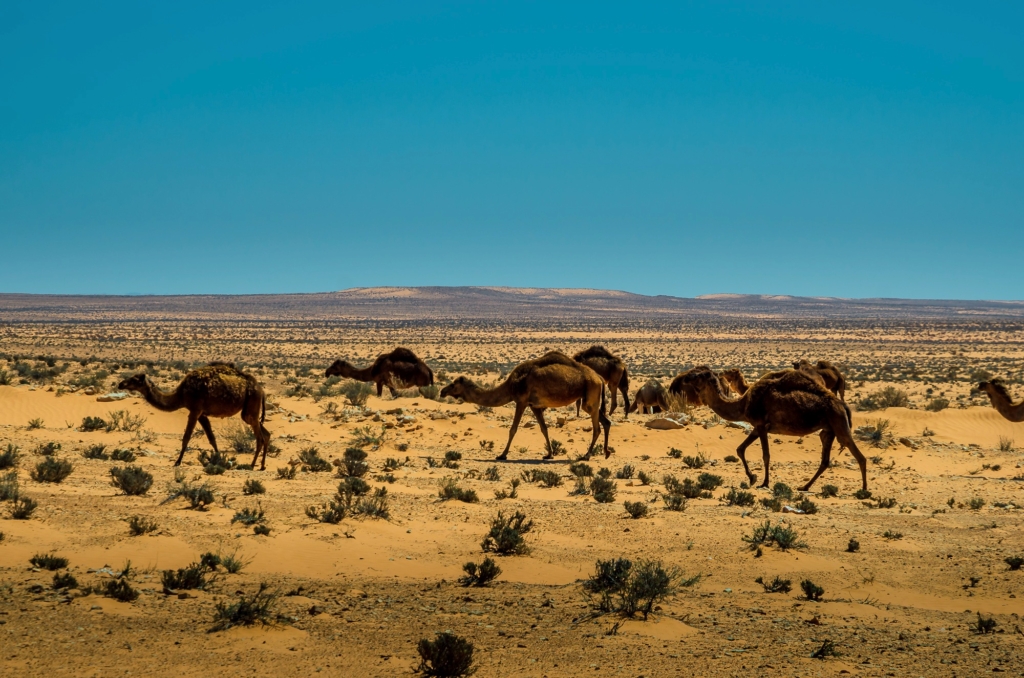
Camels are humorous to behold from a distance (you have to be careful when close, as they bite and kick). When leaving Mo Espa, we saw these two using a kilometer marker to scratch their necks.
So, observing camels is one more reason to visit Tunisia!

